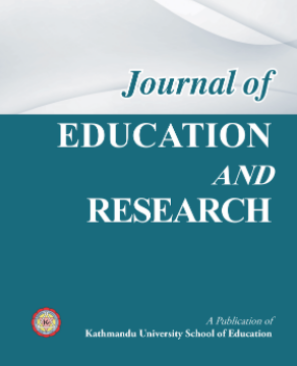
Experiences of Social Inclusion and Exclusion During Professional Entry: A Case of Women Teachers in Nepal
Original Article
Journal of Education and Research, Volume 5, Issue 1, 2015, 56-68, https://doi.org/10.3126/jer.v5i1.13058
Publication date: Mar 15, 2015
Views: 468 | Downloads: 204
How to cite this article
APA
In-text citation: (Paudyal, 2015)
Reference: Paudyal, L. (2015). Experiences of Social Inclusion and Exclusion During Professional Entry: A Case of Women Teachers in Nepal. Journal of Education and Research, 5(1), 56-68. https://doi.org/10.3126/jer.v5i1.13058
Reference: Paudyal, L. (2015). Experiences of Social Inclusion and Exclusion During Professional Entry: A Case of Women Teachers in Nepal. Journal of Education and Research, 5(1), 56-68. https://doi.org/10.3126/jer.v5i1.13058
Vancouver
In-text citation: (1), (2), (3), etc.
Reference: Paudyal L. Experiences of Social Inclusion and Exclusion During Professional Entry: A Case of Women Teachers in Nepal. Journal of Education and Research. 2015;5(1):56-68. https://doi.org/10.3126/jer.v5i1.13058
Reference: Paudyal L. Experiences of Social Inclusion and Exclusion During Professional Entry: A Case of Women Teachers in Nepal. Journal of Education and Research. 2015;5(1):56-68. https://doi.org/10.3126/jer.v5i1.13058
AMA
In-text citation: (1), (2), (3), etc.
Reference: Paudyal L. Experiences of Social Inclusion and Exclusion During Professional Entry: A Case of Women Teachers in Nepal. Journal of Education and Research. 2015;5(1), 56-68. https://doi.org/10.3126/jer.v5i1.13058
Reference: Paudyal L. Experiences of Social Inclusion and Exclusion During Professional Entry: A Case of Women Teachers in Nepal. Journal of Education and Research. 2015;5(1), 56-68. https://doi.org/10.3126/jer.v5i1.13058
Chicago
In-text citation: (Paudyal, 2015)
Reference: Paudyal, Laxmi. "Experiences of Social Inclusion and Exclusion During Professional Entry: A Case of Women Teachers in Nepal". Journal of Education and Research 2015 5 no. 1 (2015): 56-68. https://doi.org/10.3126/jer.v5i1.13058
Reference: Paudyal, Laxmi. "Experiences of Social Inclusion and Exclusion During Professional Entry: A Case of Women Teachers in Nepal". Journal of Education and Research 2015 5 no. 1 (2015): 56-68. https://doi.org/10.3126/jer.v5i1.13058
Harvard
In-text citation: (Paudyal, 2015)
Reference: Paudyal, L. (2015). Experiences of Social Inclusion and Exclusion During Professional Entry: A Case of Women Teachers in Nepal. Journal of Education and Research, 5(1), pp. 56-68. https://doi.org/10.3126/jer.v5i1.13058
Reference: Paudyal, L. (2015). Experiences of Social Inclusion and Exclusion During Professional Entry: A Case of Women Teachers in Nepal. Journal of Education and Research, 5(1), pp. 56-68. https://doi.org/10.3126/jer.v5i1.13058
MLA
In-text citation: (Paudyal, 2015)
Reference: Paudyal, Laxmi "Experiences of Social Inclusion and Exclusion During Professional Entry: A Case of Women Teachers in Nepal". Journal of Education and Research, vol. 5, no. 1, 2015, pp. 56-68. https://doi.org/10.3126/jer.v5i1.13058
Reference: Paudyal, Laxmi "Experiences of Social Inclusion and Exclusion During Professional Entry: A Case of Women Teachers in Nepal". Journal of Education and Research, vol. 5, no. 1, 2015, pp. 56-68. https://doi.org/10.3126/jer.v5i1.13058
ABSTRACT
To enter the teaching profession, apart from basic requirements set by the government, there are many other ‘rules of the game’ and ‘open secret criteria’ determining who gets included or excluded from being a teacher. The culture of aafnojat (person from own caste) and aafnomanchhe (own relatives) are found to be the most prominent ones. In this paper, I discuss that the issue of inclusion and exclusion is contextual in case of women teachers. Furthermore, the woman from elite group (near and dear of power holders and aafnojat) are getting benefits from the affirmative policy. The ideology of caste as a dominant factor of exclusion is sidelined when the interplay of power of position gets activated and other factors like powerlessness, unmarried status, non-local status, and disability greatly influence the issue of inclusion and exclusion to get into the teaching job. Hence, the existing generic knowledge that some specific caste groups are always more powerful than others is not the ground reality.
REFERENCES
---
LICENSE
This work is licensed under a Creative Commons Attribution 4.0 International License.
